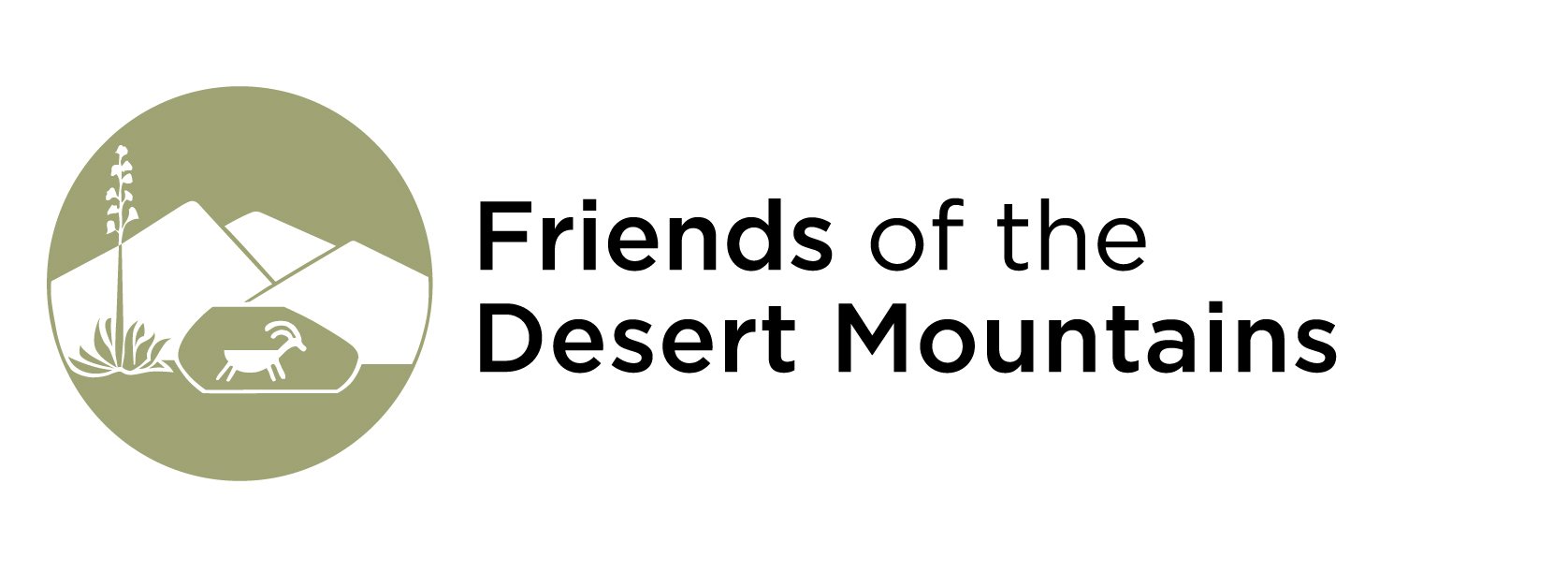Friends of Friends
The Coachella Valley spans more than 1.2 million acres - that’s one and half Rhode Islands - from mountain peaks and sandy dunes, to canyons and palm oases, not to mention hotels, golf courses, and Highway 111. Balancing the needs of wildlife and people is a complex job, managed by cities and tribes, local, state, and federal agencies, nonprofits like Friends of the Desert Mountains, and a small army of volunteers. It’s a huge challenge, often accomplished without fanfare by a small handful of dedicated individuals.
This week we’re shining a spotlight on some of the partners Friends works with to protect the wildlife, scenic views, and hiking trails of the Coachella Valley. We interviewed Kathleen Brundige with the Coachella Valley Conservation Commission, and Diana Rosas with the Coachella Valley Mountains Conservancy, to learn about their work, how they got to be where they are, and find out some of their favorite parts of the Coachella Valley. Join us in thanking them for their hard work and dedication!
Introduce yourself. Where do you work, what is your title, and what do you do?
My name is Kathleen Brundige. I have been the Conservation Management Analyst for the Coachella Valley Conservation Commission since 2014. I am the program administrator for biological monitor and land management for the Coachella Valley Multiple Species Habitat Conservation Plan. I have served for 19 years as a wildlife ecologist in the desert, mountain and coastal sage scrub regions of southern California and have taught Natural Resources for College of the Desert since 2010. I am proud to serve the conservation efforts of our desert and mountains. Much of my focus these days in adaptive management, removal of invasive species, and coordinating research on rare and sensitive species and habitats. Since together with our partners such as the FODM and CVMC we have acquired approximately 96,000 acres for conservation, along with the covered federal and state lands, there is always a multitude of monitoring and management projects to keep up with.
How did you get here? What inspired you to choose your career?
When I was a child, I grew up on the edge of an urban-wildland interface. Much of my free time was spent escaping to the open areas to get away from the noisy confines of the city. I spent so much of my youth exploring those areas and loved to draw and write about the animals and habitats I saw there. After watching so many of the natural lands in Riverside County lost to unbridled and hastily planned development in the early 90's, I knew I wanted to work with animals in their natural habitat and majored in Conservation Biology at UC Riverside. During my senior year I was introduced to the unique biodiversity of the desert and mountains through my field courses in Biogeography and Vertebrate Ecology and through a work study opportunity with the UCR Center for Conservation Biology. I adored that student position and all the aspects of conservation I learned and graduated in 2003 with a Bachelor of Science. The student position turned into a full-time position as a Junior Research Specialist monitoring rare and sensitive plant species in Western Riverside County. In my early years assisting with the Multiple Species Habitat Conservation Plans, I also became interested in increasing environmental literacy through formal K-12 and informal citizen science education initiatives. With these interests, I focused my graduate studies on investigating varying levels of ecological literacy of residents within the Coachella Valley MSHCP plan area and the effects of related environmental behaviors. In 2005, I transferred to the UCR-CCB Desert Studies Initiative focusing on research and developing monitoring protocols for the biodiversity of Joshua Tree National Park and the Coachella Valley MSHCP. Several years later, in 2014, I moved to this position, and now help the Coachella Valley Conservation Commission coordinate all of the biological monitoring and land management activities required to keep the MSHCP going well.
How has your work changed during the COVID-19 closures?
It has been a challenge. I work remotely to coordinate the biomonitoring activities, and much of our essential research activities have continued through the shut down, but I have had less opportunity to be in the field this spring to focus on land management which means we have lost precious time tending to invasive species, fencing and signage to protect lands.
What is your favorite place to spend time outdoors?
I adore the beautiful conservation lands around the western part of the Valley, especially Snow Creek, Mission Creek, and Whitewater. The landscapes from the mountains to the sand dunes to the rivers are so dramatic and extremely high in biodiversity. I also spend a lot of time on the north side of the Valley in the little San Bernardino Mountains and Joshua Tree National Park. The whole valley is gorgeous, and every conservation area provides unique and wonderful experiences. I have so many favorites, but those areas are where I tend to spend the bulk of my time. I feel so blessed to be able to experience the natural beauty here.
What is your favorite animal or plant found in the Coachella Valley?
Man, that is difficult. There are too many to love. Since you asked me to choose, my favorite plant would probably be the Coachella Valley milkvetch. Because they are endangered, I become particularly excited when I find them in sandy areas of the valley, and their blooms are so pretty. My favorite animal is tied between the burrowing owl and the desert tortoise. Both species are so unique, and you find them in the most interesting places.
Meet another one of our partners, Diana Rosas with the Coachella Valley Mountains Conservancy:



